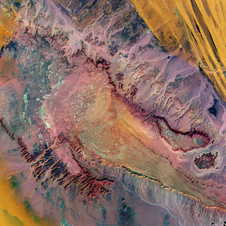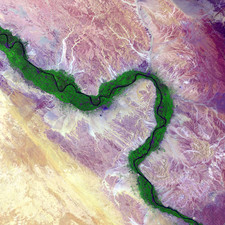OUR DESIGN
NATURE, FRUGALITY AND TECHNOLOGY
OUR PHILOSOPHY
The humanity of modern societies sees itself as what it sets apart from nature, even though we are fully dependent on healthy ecosystems. This fricative relationship - and with this, the fine line between the domination of, and integration with, nature - becomes particularly relevant in the current age of climate change: our environmental consciousness is increasing exponentially, but does this bring us closer to nature? Or does it further the alienation of humankind by stressing Enlightenment thinking, in which the Earth is dominated, controlled, and appropriated?
We explore this tension between ecocentrism and anthropocentrism at the intersection of science, society and art. This exploration reveals the relevance of techno-solutionist thinking: in our day and age, technology is frequently perceived as a silver bullet for the consequences, given its omnipresent potential with regards to the adaptation and mitigation of climate change. What is often overlooked, however, is that technology might increase our conceptual distance to nature, and therefore not tackle the root causes of climate change.
This fine line between technology and ecology, and the consequent role of humanity, lies at the heart of our design philosophy: our collective seeks creative, conceptual, and feasible ways in which technology and ecology become allies, rather than enemies, for the battle against the climate crisis.



OUR INSPIRATION
The inspiration for our designs is sought at various levels, and ranges from a wide variety of communities. The common denominator of these communities, however, is the way in which they perceive their environment: finite.
We are first inspired by space technologies and life support systems. These technologies pioneer with regards to recycling potential, and are well on their way to become fully circular systems. For the creation of our exhibition Synergy in the Ordinary, we have been particularly drawn to extraterrestrial farming in space contexts and the circular water treatment systems present in spaceships. The reverse osmosis filter, pink grow lights, and micro-algae are - amongst others - some of the space-elements present in our exhibition.
Seemingly the opposite, but secretly highly similar, are Cistercian monasteries, that serve as another important source of inspiration for our designs. Following the Benediction Order, the life of these monks centres around the Supernatural, but their time on Earth is fully devoted to treating nature as a respectable entity, and ensuring a safe and inhabitable home for future generations. This calling is operationalised through the three Cistercian principles of silence, sobriety, and solidarity - based on frugality, equality, and circularity - and operationalised through, amongst others, growing their own crops, recycling water where possible, and living an overall minimalist lifestyle.
Our last major source of inspiration is drawn from eco-villages and earthships that follow the principles of biotecture. As an active stream of architecture that fights capitalist and linear thinking, these living structures allow for a sustainable, circular, and fully off-grid lifestyle. In particular their decentralised water harvesting methods, black- and grey water treatment systems and food production possibilities are incorporated into our designs.



NATURE AS
PROTAGONIST
With climate action becoming ever more urgent, we should soon begin to witness a paradigm shift to ecocentrism, wherein nature will come to take centre stage in the decision-making process of our societies. Nature as a respectable entity that deserves moral rights regardless of its economic gain to us lies as the centre of this philosophy: contrary to the current view of nature as mechanical tool that fuels capitalism, this thought moralises our perception of nature, and thereby introduces it as a moral entity that deserves the same integrity as all other living beings.
When viewing nature as a respected entity, the optimisation of ecosystem services is more likely to transform from exploitation to cooperation. Our designs explore the intersection of these arguments, and explore various ways in which ecosystem services can be optimised from the perspective of nature as one moral entity: when nature is not seen as a means towards, but rather as a respectable entity, this convergence of views provides a promising path out the climate crisis.



LET'S THINK LIKE
AN ASTRONAUT
The rapidly growing threats stemming from climate change urge us to view the planet we call home as a finite resource that is currently moving into decay and extinction. Only by realising that the natural resources are not infinitely available to humanity, is it that we stand a chance against the pressing threats of climate change. Anticipating this, our designs challenge you to start thinking like an astronaut, or rather, start treating the earth as a spaceship, in order to - together - move to a sustainable planet in which all of our resources are - rightfully so - treated finitely.



FRUGALITY
Doing more with less lies at the core of frugality. Proximate to a simple and minimalist lifestyle, frugality is often referred to as the careful management of resources - whether these be economic, natural, temporal, or capital. Within recent years, frugality has rapidly been gaining attention with regards to decentralised climate action: a growing number of people try to use their resources as frugally as possible, whether this be through reusing, repurposing, recycling, or reducing.
Frugality in light of the current climate crisis lies at the core of our designs: water is recycled where possible through systems that simultaneously grow herbs, plant roots and helophytes are used as effective water treatment systems, the potential of rainwater is fully harvested, and micro-algae serve as natural nutrition, both for plant and human.
The power of this frugality is reinforced by the accessibility of these mitigation solutions: requiring very little high-tech and expensive components, the concepts behind our designs are feasible and realistic for usage in a wide variety of resource-scarce contexts.